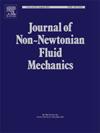Turbulence characteristic evolution in jets interacting with viscoplastic fluids
IF 2.8
2区 工程技术
Q2 MECHANICS
引用次数: 0
Abstract
We experimentally study the dynamics of a horizontal jet of a Newtonian fluid injected into a viscoplastic ambient fluid (Carbopol gel) to simulate jet cleaning in plug and abandonment operations of oil and gas wells. The jet flow is analyzed using high-speed imaging, planar laser induced fluorescence, and time-resolved tomographic particle image velocimetry techniques to capture concentration and velocity fields with high spatial and temporal resolution. By varying the Reynolds and Bingham numbers, we analyze three recently identified flow regimes, i.e., mixing, mushroom, and fingering, focusing on their mixing index, velocity fields, fluctuation intensity, half-radius, vorticity, Reynolds stresses, probability density functions, and statistical moments (skewness and kurtosis). In the mixing regime, velocity and vorticity symmetry, axisymmetric mixing, and dominant axial Reynolds stresses align with Newtonian empirical correlations. The mushroom regime shows slight asymmetry, reduced mixing from turbulence suppression by yield stress, and moderate turbulence, while the fingering regime features pronounced asymmetry, erratic fluctuations, and suppressed velocity due to viscoplastic resistance. Self-similarity analysis of velocity, concentration, and Reynolds stress profiles confirms strong scaling in the mixing regime, partial scaling in the mushroom regime, and deviations in the fingering regime, where viscoplastic effects disrupt jet structure and turbulence.
射流与粘塑性流体相互作用的湍流特性演化
实验研究了将牛顿流体注入粘塑性环境流体(Carbopol凝胶)的水平射流动力学,以模拟油气井封堵和弃井作业中的射流清洗。利用高速成像、平面激光诱导荧光和时间分辨层析粒子图像测速技术对射流进行分析,以获得高时空分辨率的浓度场和速度场。通过改变雷诺数和宾厄姆数,我们分析了最近发现的三种流动形式,即混合流、蘑菇流和指指流,重点研究了它们的混合指数、速度场、波动强度、半半径、涡度、雷诺应力、概率密度函数和统计矩(偏度和峰度)。在混合状态下,速度和涡度对称、轴对称混合和主导轴向雷诺应力与牛顿经验相关。蘑菇模式表现出轻微的不对称,屈服应力抑制湍流导致的混合减少,湍流适度,而指法模式则表现出明显的不对称、不稳定波动和粘塑性阻力导致的速度抑制。速度、浓度和雷诺应力分布的自相似分析证实了混合状态下的强结垢,蘑菇状态下的部分结垢,指法状态下的偏差,粘塑性效应破坏了射流结构和湍流。
本文章由计算机程序翻译,如有差异,请以英文原文为准。
求助全文
约1分钟内获得全文
求助全文
来源期刊
CiteScore
5.00
自引率
19.40%
发文量
109
审稿时长
61 days
期刊介绍:
The Journal of Non-Newtonian Fluid Mechanics publishes research on flowing soft matter systems. Submissions in all areas of flowing complex fluids are welcomed, including polymer melts and solutions, suspensions, colloids, surfactant solutions, biological fluids, gels, liquid crystals and granular materials. Flow problems relevant to microfluidics, lab-on-a-chip, nanofluidics, biological flows, geophysical flows, industrial processes and other applications are of interest.
Subjects considered suitable for the journal include the following (not necessarily in order of importance):
Theoretical, computational and experimental studies of naturally or technologically relevant flow problems where the non-Newtonian nature of the fluid is important in determining the character of the flow. We seek in particular studies that lend mechanistic insight into flow behavior in complex fluids or highlight flow phenomena unique to complex fluids. Examples include
Instabilities, unsteady and turbulent or chaotic flow characteristics in non-Newtonian fluids,
Multiphase flows involving complex fluids,
Problems involving transport phenomena such as heat and mass transfer and mixing, to the extent that the non-Newtonian flow behavior is central to the transport phenomena,
Novel flow situations that suggest the need for further theoretical study,
Practical situations of flow that are in need of systematic theoretical and experimental research. Such issues and developments commonly arise, for example, in the polymer processing, petroleum, pharmaceutical, biomedical and consumer product industries.

 求助内容:
求助内容: 应助结果提醒方式:
应助结果提醒方式:


